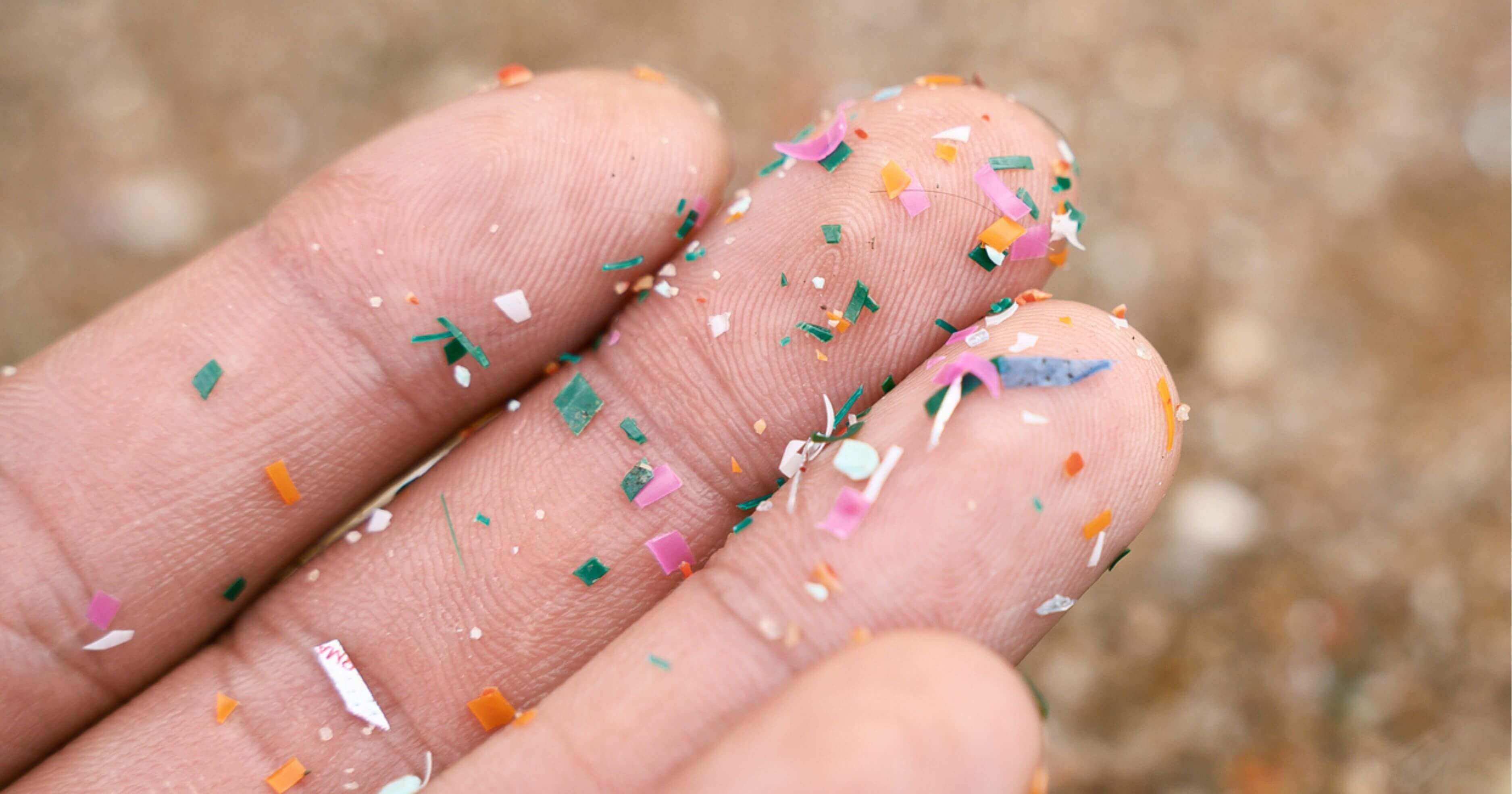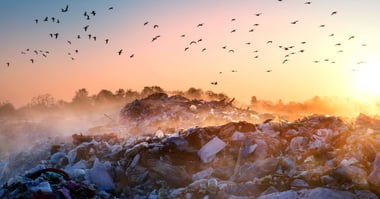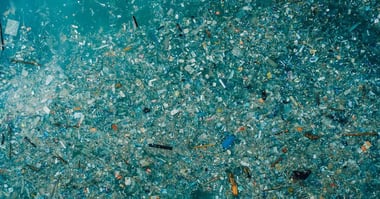Humans consume and inhale up to 211,000 microplastic particles in a single year (American Chemical Society, 2019). That is estimated six times more microplastics than in 1990 (Health Policy Watch, 2024).
As a result of our planet’s unprecedented demand for plastic, microplastics have become a standard part of our daily lives — even if we can’t see them.
Microplastics can now be found on top of our planet’s highest mountains and at the bottom of our deepest oceans. These tiny particles move in our air, through water systems, and even animal and human bodies. In short, they lurk in every corner of our planet’s ecosystems.
It's even got Orlando Bloom splashing out £10,000 for a treatment to remove microplastics and toxic chemicals from this blood!

Despite the prevalence of microplastics, scientists are only just starting to discover their impact on our ecosystems and health.
At the same time, little has been done to limit the amount of microplastics entering our environment. The volume of microplastics on the sea floor has tripled over the last two decades (Science Daily, 2022), and studies indicate our planet’s microplastic problem will continue to escalate.
We know this a lot to take in. But understanding the scale of the problem is important. And you clearly care, because that's what brought you to this blog post in the first place.
So let's get stuck in and take a look at what you need to know about the impact of microplastics on our world.
What’s on this page?
01 | What are microplastics?
02 | Where do microplastics come from?
03 | Why are microplastics bad for the environment?
04 | How do microplastics impact human health?
05 | Can we remove microplastics from the environment?
06 | Do water company treatment plants remove microplastics?
07 | Summary
08| FAQs
What are microplastics?
As their name suggests, microplastics are minuscule plastic pieces smaller than 5 millimeters (mm) in diameter. Often derived from larger plastic products that have broken down over time, microplastics aren't biodegradable, meaning they’ll continue polluting the environment (and breaking down even further) for hundreds of years.
Microplastics' size makes it easy for these particles to seep into all parts of our daily lives. As a result, they gather in soil and oceans, food supplies, and drinking water.
In 2022, studies found microplastic particles in 80% of human blood samples they collected. At the same time, scientists have yet to understand how microplastics fully threaten human and animal health.
The difference between primary and secondary microplastics
The term ‘microplastics’ is often used to describe all types of tiny plastic particles. However, scientists consider two different types, based on where they come from.
- Primary microplastics —These plastic particles are specifically designed to be this small. For example, microbeads used in beauty products and microfibres found in some types of clothing are classed as primary microplastics. These microplastics seep into the environment when the product is used, such as when you wash synthetic clothes. Studies have also found that zooplankton and some fish ingest primary microplastic, concluding they “can cause both physical and chemical harm.”
- Secondary microplastics — These are plastic fragments that have broken down from larger plastic items. Some of the most significant sources of secondary microplastics come from plastic waste floating in our oceans, which wears down over time through processes like photooxidation (where sunlight and oxygen wear down the plastic). Between 69% and 81% of microplastics found in our seas are identified as secondary microplastics.
The difference between microplastics and nanoplastics
Nanoplastics are formed by even further fragmentation of plastic particles. These particles are smaller than microplastics and measure less than one micrometer (70 times smaller than a strand of human hair). They’re impossible to spot with the naked eye — and even some microscopes can’t detect them.
Initial studies have shown that nanoplastics are so small they can pass through cell membranes. The World Economic Forum said that our understanding of nanoplastics is limited, but scientists have found that they can impact the development of marine life and change their cells.
Alarmingly, nanoparticles have already been detected in places like the North and South Pole, meaning they’re likely already having a major impact on our planet.
Where do microplastics come from?
Microplastics are derived from other plastics and come from many different sources, including single-use plastics, personal care products, clothing, construction materials, and ocean-based sources.
Single-use plastics
Plastic bags, plastic bottles, food packaging, and even COVID-19 face masks contain synthetic materials that don’t biodegrade. Instead, they undergo a process of photodegradation, where the sun’s UV rays break down molecules into smaller particles.
Plastic bags, used for an average of 12 minutes, can take hundreds of years to photodegrade. These particles break down into microplastics that are washed into our environment.
Personal care products
A 2020 study found that 70% of personal care and cosmetic products contained microbeads, mostly made from a type of plastic called polyethylene (PE). Manufacturers add microplastics (such as microbeads) to cosmetics, shampoos, hair sprays, and creams to improve the texture, durability, and exfoliating properties.
These microplastics are quickly washed away after initial use, eventually entering our environment. The Frontiers report also revealed that an estimated 37 billion microbeads leak into the environment each year through wastewater.
Clothing
At least 62% of clothing uses synthetic materials, such as polyester, acrylic, and nylon. These materials contain tiny microplastic fibers that escape into the environment throughout the garment's lifespan.
When you wash a garment, the fibers can wear down and leak into the water. Because these particles are so small, some wastewater processing plants release the water into lakes and rivers.
According to the UN Environment Programme, half a million tons of plastic microfibres end up in the ocean from laundry alone — but that’s not all. Textiles also release microplastics into the air when worn or dried. Studies have found that 65% of microplastics that are released into the air happen through these methods.
The issue is even worse when considering the fast fashion industry, a booming market that prioritizes synthetic materials, low costs, and fast manufacturing. The European Environment Agency states that fast fashion clothes release “particularly high levels” of microfibres.
As brands poorly make these products, customers often dispose of fast fashion products quicker than other items — adding to microplastic levels entering the environment.
Construction materials
Microplastics can also be found in concrete, paints, and plastic building materials, contributing to a large proportion of plastic particles entering the environment each year.
Among these materials, researchers have found that paint is one of the most significant contributors to ocean microplastics — amounting to 58% of particles in the sea. More than a third of paint particles entering the ocean do so because of mismanagement of materials.
Not only does it impact our oceans, but construction materials can also severely impact human health. During construction, plastic particles can enter air supplies, making them prone to inhalation by workers.
Ocean-based sources
Sea-based activities, such as fishing and shipping industries, also contribute to mounting ocean microplastics. In fact, up to 20% of microplastics come from ocean-based sources.
Discarded fishing nets threaten marine life but will also break down like other plastic materials — adding to ocean microplastics.
Want to reduce your business’s plastic footprint? We can help. All you have to do is get in touch with our in-house team using the form below. Once we’ve received your details, we can arrange a call to discuss which plastic recovery plan best suits your business needs.

Why are microplastics bad for the environment?
Microplastics have been around for decades, but the negative impacts of these tiny particles have only come into focus in recent years. Longer-term investigations will be needed to fully understand the effects of microplastics, but here’s what we know already.
Seeps into soil
Plastics gathering in overflowing landfills will break down into microplastics that seep into the soil.
Some studies have found that microplastics can destroy the structure of the soil, making it hard to filter and irrigate water. This can impact the ability to grow crops and negatively impact the regeneration of natural landscapes.
Moreover, organisms living in soil, such as worms, can ingest these microplastics, which quickly work up the food chain.
Contaminates water supplies
Studies have found varying quantities of microplastics in lakes and rivers worldwide — but how does it get there?
Primary wastewater treatment usually removes between 16.5 and 98.4% of microplastics, meaning most conventional waste treatment plants don’t fully eradicate microplastics. If this water is released, microplastics can enter freshwater systems.
Plastic trash in our rivers and lakes will similarly break down into microplastics.
More alarmingly, microplastics can also get into drinking water supplies, including tap and bottled water. While some plastic particles are already in the water before they enter drinking supplies, microplastics can also enter water supplies from their containers.
Compared to tap water, researchers in early 2024 found bottled water contained up to 240,000 tiny pieces of plastic, of which 90% were nanoplastics.
Ingested by marine life
Given the considerable amounts of plastic particles in water systems, it's unsurprising that much of this will end up in our oceans. Here, it’s ingested by countless marine organisms, meaning these particles rapidly ascend the food chain.
A shocking scientific report from 2021 revealed that of the 240 specimens of fish, squid, and shrimp they studied, 100% contained microplastics.
It’s not just a threat to food sources; microplastics also threaten the health of marine animals. A 2022 study highlighted microplastics' negative impact on marine life, claiming they impact feeding behavior and fertility, and cause structural damage to fish intestines, liver, gills, and brain.
How do microplastics impact human health?
Plastic impacts human health in multiple ways, but there haven’t been a lot of studies about the role that microplastics play in this yet. However, scientists have found microplastics in human blood, within the placenta, and various human organs, showing that microplastics can and do travel around the human body.
The United Nations Development Program noted that microplastics often contain chemicals considered hazardous to human health.
Some of these chemicals lead to hormone imbalances, decreased reproductive health, and cancer. According to the New York Post, the ‘forever chemicals’ found in microplastics even contribute to a $250 billion health crisis in the US.
Find out more about this topic by visiting our page: How Does Plastic Affect Human Health?
Can we remove microplastics from the environment?
The impact that microplastics have around our world is concerning. Luckily, a number of projects are trying to collect and remove microplastics from the environment, from wastewater, and from drinking supplies.
While there are varying degrees of success, developments in this field are quickly gathering pace.
In 2021, scientists proposed using bacteria to collect microplastic particles. The team aimed to create an adhesive ‘biofilm’ out of bacteria that captures microplastics. Questions, however, remained over how scalable such a project could be.
The same year, another group of researchers claimed to have found a way to eliminate microplastics in wastewater with an electrolytic treatment. According to reports, the process breaks the microplastics into carbon dioxide (CO2) and water molecules, meaning it’s better for the environment.
Enacting microplastic removal processes on a wide scale will prove challenging. Funding opportunities are scarce, and existing projects seem fragmented and small-scale. However, it’s not impossible.
At the same time, we must tackle the root cause of the problem by reducing the reliance on plastic materials where possible. A recent article published by the University of Leeds found that more than two-thirds of the annual 57 million tons of plastic pollution comes from countries in the Global South.
This is because as well as the over-reliance on single-use plastics, there are countless countries where no waste collection system exists. Without an effective waste management system, individuals are left to either discard in nature or burn waste.
That's why at CleanHub, we chose to focus on plastic recovery, rather than traditional recycling or waterways cleanups, because the problem starts earlier. By preventing the plastic from being dumped in the first place, we're preventing the plastic breaking down in the environment and producing microplastics.
Find out more about supporting our work here.
Do water company treatment plants remove microplastics?
Regulation surrounding water quality varies depending on where you are in the world. In most developing countries, for example, populations rely on drinking bottled water because safe tap water provisions simply don’t exist.
The way that authorities treat water also depends on your location. However, water treatment plants can help to remove microplastics from water supplies. In 2020, researchers found that water companies in the Netherlands removed an average of 72% of plastic particles from wastewater during primary treatment. This percentage goes up based on the number of rounds of treatment. Wastewater treatment plants (WWTP) use various strategies to remove the microplastics, such as filtration, chemical treatments, and advanced technology.
In some instances, water treatment is nearly 100% effective. In 2019, reports claimed that 99.9% of microplastics were removed from UK drinking water during treatment.
Two years later, however, The Guardian reported that water firms were also the main source of microplastics in UK rivers. Untreated wastewater spillages aren’t uncommon, suggesting room for improvement in existing water treatment practices.
What can you do right now?
There is a myriad of ways you can both protect yourself and make a difference to microplastics entering the environment. In fact, in many cases they work hand in hand, reducing the release of microplastics into the environment and into your body.
Here are five ways you can avoid consuming and releasing microplastics starting now!
- Ditch single use plastic bottles and use a stainless steel refillable. Check out Ocean Bottle.
- Avoid storing and heating food in plastic. Putting plastic in the microwave is a no no.
- Wash any plastic you use by hand. Avoiding putting plastics the dishwasher helps your health and reduces microplastics reduced into the environment. Even Finish, dishwasher experts tell us this.
- Using wood or bamboo chopping boards are said to reduce the release of microplastics getting into food during preparation
- Opt for plastic-free tea bags. Again, this reduces the consumption while drinking and then the release of the microplastics when dumped into landfill. The other benefit of plastic-free tea bags is they can be composted and turned into worm food. Grab a bag of Pluck and pop the kettle on. Or for our readers in the UK, check out Tease for a plastic free cuppa.
Summary
We may not always be able to see them, but microplastics clearly pose a huge threat to the health of our planet, and ourselves.
At the same time, plastic manufacturing continues at an unprecedented pace around our planet, meaning the long-term impact of microplastics could be felt for centuries to come.
Tackling microplastics won’t be achieved through a single route. Instead, scientists, governments, and individuals need to come together and take collective action to stop the rise of microplastics.
You can help us prevent plastic waste reaching waterways by supporting the collection of plastic waste in highly polluted coastal regions around the world. Check out our plans here.
FAQs
How can we prevent microplastics in daily life?
To reduce the microplastics you encounter daily, consider swapping plastic products and packaging for sustainable alternatives. Cut out drinking bottled water, relying on plastic straws, or eating food stored in single-use plastic containers.
Are microplastics harmful and how can we avoid them?
Microplastics are known to be harmful to marine life. While more research is needed in this field, initial studies also suggest that they threaten human health. It’s hard to avoid microplastics, but reducing reliance on plastic products is an excellent first step. You can find out which products to ditch to avoid microplastics in our new comprehensive guide.
How can we prevent microplastics in food and water?
While it's hard to prevent microplastics altogether, there are ways to limit them in food and water supplies. From an individual point of view, any reduction of microplastics in our daily lives can have a positive effect. Familiarize yourself with what foods contain the most microplastics, and try to avoid heating food in plastic and drinking from plastic bottles and cups.

.jpg)
-3.png)


.webp?width=380&name=solar-collection%20(1).webp)

.webp?width=380&name=Colourful%20corals%20(1).webp)
.webp?width=380&name=Plastic-pollution-surface-of-water%20(1).webp)

%20(1).webp?width=380&name=Plastic-on-the-beach%20(2)%20(1).webp)

.webp?width=380&name=recycling%20(1).webp)
